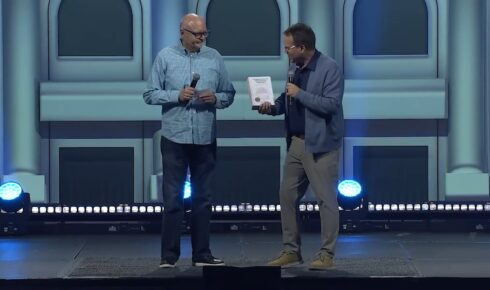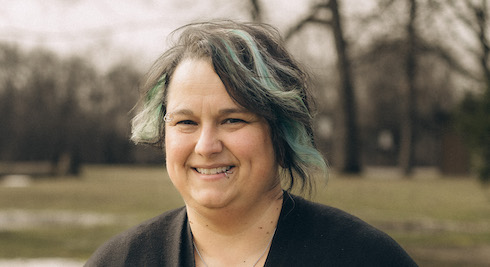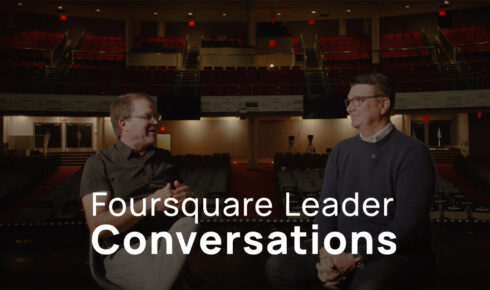There’s another side to the story of Foursquare’s numbers, and it’s being told in other languages. For while official records may show a drop in the number of the movement’s churches in the U.S., that count overlooks an encouraging growth area: the multiplication of congregations reaching immigrant or ethnic communities that are not always recognized independently from their host English churches, even though they function autonomously, because they are not formally separate.
Those “hidden” churches could swell the ranks of Foursquare churches from its 1,750 or so in the U.S. to as many as 2,000, says Ted Vail, associate director of Foursquare Missions International—U.S. Missions. He estimates Foursquare’s international churches in the U.S. at between 400 to 500, many of them being led by foreign national church planters.
Among them is El Kiosco (San Bernardino North Hispanic Foursquare Church) in San Bernardino, Calif., pastored by Yaseer and Monique Handall. Taking its name from the Spanish word for the community gathering spot in many South American towns, the church aims to be the same kind of central place “for celebration and community,” says Yaseer, originally from Mexico.
In the seven years since it began with three people—the Handalls and a relative—El Kiosco has grown to around 100.
“For many people whose other relatives are back home, we are the only family they have,” Yaseer tells foursquare.org. “We try to really care about people. We have some people who don’t speak Spanish who come because of the connection; they feel that they are accepted.”
The Handalls have also extended their boundaries by taking Foursquare principles and teaching them to Native American communities across the Southwest.
Forming Community
The desire for community with others from a similar background is fertile ground for ministry. It drew Edicarlo Dos Santos to church and then to Christ when he came to the U.S. from Brazil to work in 1996.
“When you are an immigrant, you miss people, and if you don’t speak English, you can feel a little alone,” he recalls.
Now Edicarlo pastors Lowell Portuguese Foursquare Church, a Brazilian congregation in Lowell, Mass., one of around 200 in the state. His wife, Eni De Paula, serves as assisting minister.
“We help with things like translation,” Edicarlo says of the church’s outreach to Portuguese speakers. “They need to go to the schools or the courts or for other appointments, and we help them.”
Habil Biswa understands the frustration faced by immigrants learning to deal with new customs, culture and systems. He came to the U.S. with his family in 2009 from Nepal, having spent almost 20 years in a refugee camp there after being forced to flee his native Bhutan. He now serves as senior pastor of Living Worship Nepali Church (Denver Central Nepali Foursquare Church) in Colorado, a fellowship of around 25 families, most from Hindu backgrounds.
“It can be very hard for them,” Habil says of the several thousand Bhutanese and Nepali refugees settled in the area. “They need help with paperwork. We welcome them and share the word of the Lord with them.”
Habil Biswa and other international church planters are coming to the U.S. in increasing numbers, says Ted Vail. Their status as students or retired, however, may mean they have not always been officially recognized by Foursquare, because ministerial accreditation required an employment form for which they may not have qualified.
“We had no strategy [for international church planters], and inadvertently had policies which were not friendly to incoming pastors,” Ted admits. Recent changes, such as translating Foursquare policies and documents, have been symbolic of the movement’s recognition of the importance of the overseas help, he says.
So too was the ratification at Connection 2012 in Phoenix earlier this year of a statement on immigration acknowledging that God brings people to the U.S. not just so they can be reached with the gospel, “but so they can partner with us in ministry.”
Looking to the Future
Sang Chan Kim pastors a Korean congregation that is part of The Church of Living Water (Olympia Foursquare Church) in Olympia, Wash. A missionary to the Philippines, he came to the U.S. in 1997 to study more and stayed on to join the international outreach opportunities available here. His church service is in Korean, but with a PowerPoint translation for American spouses and second-generation members.
That practice in part highlights a big issue for ethnic congregations: Growing up in two worlds, the children of immigrants often have less desire or need for the traditions and ways of their parents, and are more open to mixing cultures. So while ethnic and immigrant churches are vibrant now, those involved recognize that their future shape and makeup will need to morph in the years ahead.
In his area, Edicarlo Dos Santos sees the shift being fueled by the dip in Brazilian immigrants to the U.S., in part because of the improved economy back there.
“That means we are going to have to rethink what we do,” he says, “if our children don’t speak Portuguese and their parents are learning English bit by bit. I believe that the future is going to be more multiethnic.”
Ted Vail agrees, though he sees singular ethnic congregations being a vital part of the mix for some time.
“There’s a big push for multiethnic congregations, and I’m very much involved in that,” Ted affirms, “but you can’t get to a second-generation church if you don’t win the first generation.”
Anglo pastors should not just leave outreach to ethnic communities to others, says Edicarlo. He believes that as symbols of much that immigrants aspire to in their new homeland, such as status and stability, American church leaders have a largely untapped open door for ministry in front of them.
“White churches are not aware of the opportunities they have,” Edicarlo says. “If they only knew how much an immigrant appreciates it when they reach out and care about them. Even if they don’t speak the language, if they give a little bit of care and time, they are going to be able to win a whole lot more people.”


